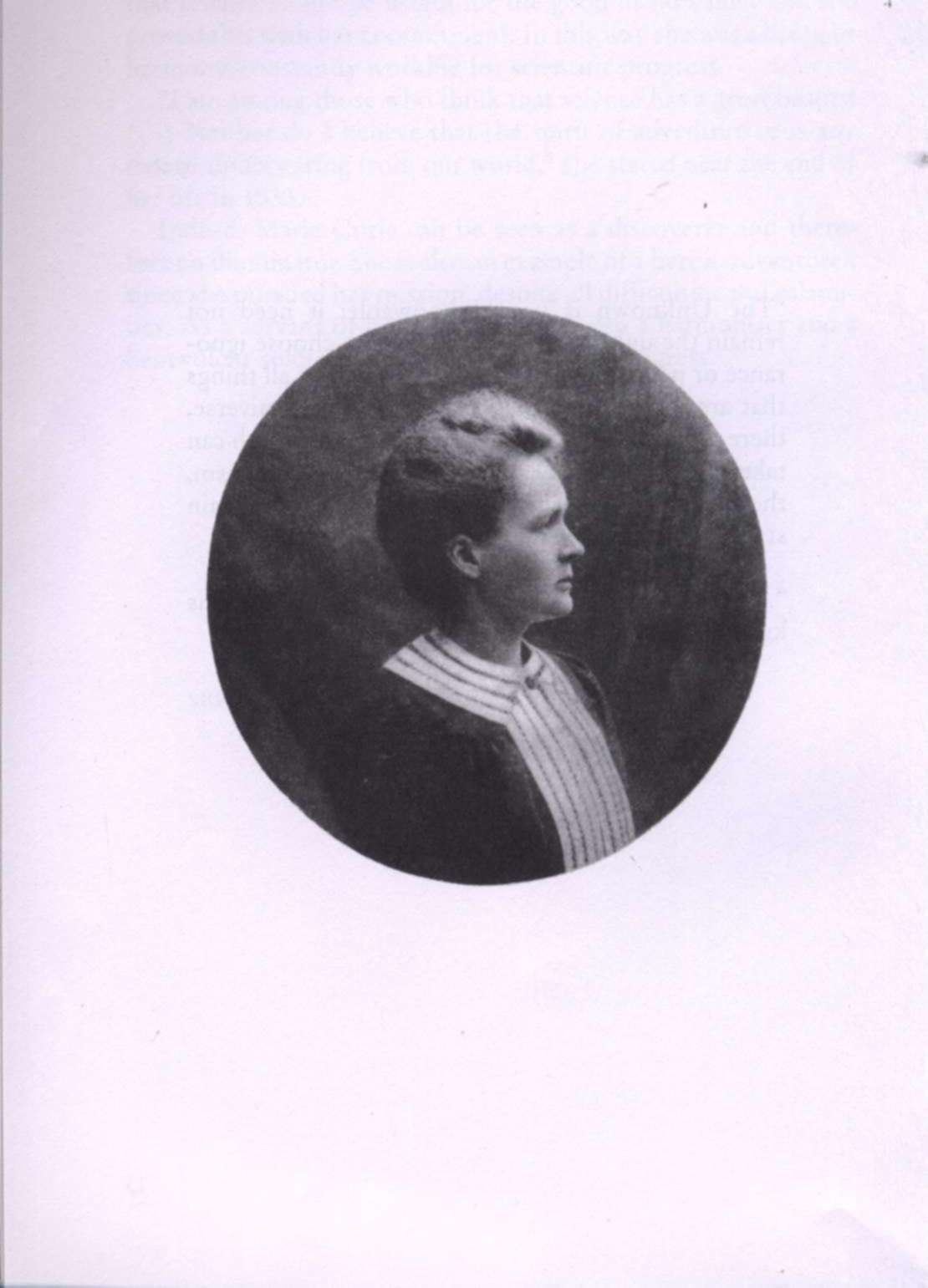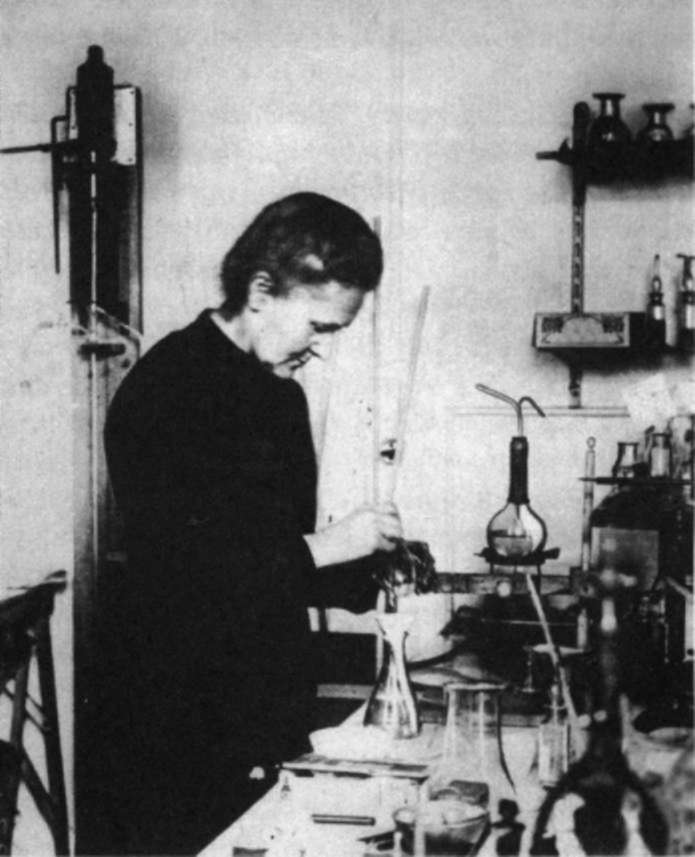Marie Sklodowska Curie - Introduction

Introduction
There are some lives more than others that are marked by destiny and whose extraordinary path is the stuff of which legends are made. Marie Curie, known as one of the greatest scientific geniuses of the century, was also a woman who knew, when needed, how to actively engage herself in the service of science. She entirely devoted herself to scientific research, having made this choice very early in her life and no obstacle could ever divert her from her mission.
Yet the obstacles were numerous: Marie was poor, she was born in an occupied country, Poland, under the yoke of Russia, and she was a woman in a world in which studies were reserved for men. Later, grief, solitude and illness did not succeed to discourage her. She gave herself with ardour to the ideal of science dedicated to progress and it is thus that after having isolated radium, she would develop applications for this discovery, especially in the therapeutic domain.
Marie had several dreams and she fought for them: there was her patriotic dream of national liberation, because her country was oppressed by Russia and Marie dreamt of a free Poland. In Warsaw she became very quickly aware of the danger it represented to express herself in her mother tongue and to be an intellectual. There was her humanitarian dream, to relieve human
suffering, to educate people: she realized this and gave the world the means to treat serious illnesses. She who so much loved to learn dedicated part of her life to transmitting knowledge: already in adolescence, wishing for social justice she devoted herself to the education of children with inadequate means. And finally there was her greatest dream, her scientific dream: even as a young girl she had been fascinated by her father's physics apparatus. She was ready to sacrifice this dream to help her family but destiny intervened. Entering a laboratory of physics and chemistry for the first time, she met the force of her vocation. The call of science was so strong! It was an inner call that Marie could not resist: she had to study, study everything that science had discovered. So she decided to leave her family and her country.
In Paris, where she studied at the Faculty of Sciences at the Sorbonne, the most prestigious university of the time, Marie was a woman, in a century in which universities were essentially open to men. For Marie, it was also the struggle of a woman who stood out in a society that reserved for men certain domains of knowledge and responsibility that lead to teaching and research.
Sometimes she paid dearly as she broke the taboos of that settled society and in spite of the prejudice and scepticism of her colleagues she was at the forefront. When Marie launched into research, she fought her greatest battle. She had the intuition that the astonishing radiation emitted by uranium, the origin of which no one knew, was due to the existence of a new element. Her hypothesis was daring, but Marie did not hesitate. With perseverance and a self-confidence out of the ordinary, she went looking for this substance, in the heart of a ton of raw material. The element hitherto unknown was Radium. With her husband the physicist Pierre Curie, she succeeded in isolating Radium in conditions of exceptional difficulty. Pierre and Marie knew nothing of the dangers of the radiation of this radioactive material which they exposed themselves to daily.
A spark of genius, years of crushing work, Pierre and Marie gave birth to a new science: radioactivity, following it through its first steps.
When her companion died an accidental death, Marie was devastated hut did not abandon the work. To accomplish the mission that she had been given, she went to the limits of her strength. Marie, a force in action, from the deadly battlefields of World War I, where she took her place at the front as the director of the new mobile radiological service which she created, to her almost permanent struggle against fatigue and pain due to exposure to radiation that ruined her health before killing her.
Before her death in 1934, she had created an Institute of Radium in both Paris and Warsaw, trained numerous scientists to succeed her and left as a testament to future generations of researchers, what only she could have written: a monumental work about radioactivity.
Even more extraordinarily, Marie, two time winner of the Nobel Prize, passed the torch to her daughter Irene Joliot-Curie, who carried out research with her husband Frederic Joliot. For their discoveries in artificial radioactivity, they received the Nobel Prize in Chemistry in 1935: five Nobel Prizes in the same family, a unique occurrence.
Marie Curie lives in our memory as an exceptional person: one who was fired up by the ideals of justice, peace and social progress. She had the genius of discovery, the intuition that science could open the doors of a new world. Among scientists and geniuses, Marie Curie remains a legendary figure, a unique example of grandeur of soul and simplicity of heart.
To illustrate this monograph we have drawn from the biography written by Eve Curie in 1938, four years after Marie's death. Eve, the youngest daughter of Pierre and Marie Curie, lived in New York where she died at the age of 103 on 26 October 2007.
In the introduction to her book, Madame Curie, Eve Curie wrote: "It would have been a crime to add the slightest ornament to this story, so like a myth. I have not related a single anecdote of which I am not sure. I have not deformed a single essential phrase or so much as invented the colour of a dress. The facts are as stated; the quoted words were actually pronounced."
The rigour of Eve Curie is a tribute to the scientific spirit, that her parents cherished; it is for this reason that we have chosen this source from among numerous other biographies available. As additional material, extracts have been taken from Autobiographical Notes" written by Marie Curie in 1923.

Marie Curie at work in her laboratory, 1911
Related Books
- Alexander the Great
- Arguments for The Existence of God
- But it is done
- Catherine The Great
- Danton
- Episodes from Raghuvamsham of Kalidasa
- Gods and The World
- Homer and The Iliad - Sri Aurobindo and Ilion
- Indian Institute of Teacher Education
- Joan of Arc
- Lenin
- Leonardo Da Vinci
- Lincoln Idealist and Pragmatist
- Marie Sklodowska Curie
- Mystery and Excellence on The Human Body
- Nachiketas
- Nala and Damayanti
- Napoleon
- Parvati's Tapasya
- Science and Spirituality
- Socrates
- Sri Krishna in Brindavan
- Sri Rama
- Svapnavasavadattam
- Taittiriya Upanishad
- The Aim of Life
- The Crucifixion
- The Good Teacher and The Good Pupil
- The Power of Love
- The Siege of Troy
- Uniting Men - Jean Monnet